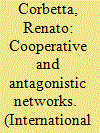| Srl | Item |
| 1 |
ID:
120877


|
|
|
|
|
| Publication |
2013.
|
| Summary/Abstract |
In recent years (social) network approaches have been gaining ground in the field of international relations. Networks between states effectively explain patterns of international conflict and cooperation. One issue where conflict and cooperation converge-and where network analysis finds fruitful application-is the issue of third-party states' intervention in conflicts. This study investigates whether, and how, conflict expands in the international social space through the cooperative and antagonistic networks generated by states' supportive and oppositional interventions in international disputes. The study adopts a sociological theory of social units' interaction in the social space as a function of their multidimensional affinity to investigate further how such networks form. The hypotheses derived from this theoretical framework are tested using data on third-party non-neutral intervention in post-World War II militarized interstate disputes from Corbetta and Dixon (2005). Proximity in the international social space effectively predicts the creation of cooperative ties (supportive interventions) between states, while social distance predicts antagonistic ties (oppositional interventions).
|
|
|
|
|
|
|
|
|
|
|
|
|
|
|
|
| 2 |
ID:
095593


|
|
|
|
|
| Publication |
2010.
|
| Summary/Abstract |
The decision to intervene in ongoing conflicts is one of the most difficult foreign policy choices states often face. Yet, studies of third parties' joining behavior have been rare and limited in several respects. First, they have explored only a subset of all interventions-military interventions. Second, they have concentrated on security-based determinants of intervention-power and alliance considerations-while underplaying other possible motivations behind the decision to intervene. Third, they have explored intervention and alignment choices as separate issues. This paper proposes a model of joining behavior that includes both security considerations and homophilous network ties as determinants of third parties' intervention and alignment choices. The model is tested on military and nonmilitary interventions data from Corbetta and Dixon (2005) for the 1946-2001 period. The results from a boolean logit estimation indicate that (1) the intervention decision is the result of both security-driven, pragmatic considerations and homophily between joiners and disputants; and (2) opposition to a party in a conflict is as important as a third party's social proximity to the side being supported.
|
|
|
|
|
|
|
|
|
|
|
|
|
|
|
|
| 3 |
ID:
162443


|
|
|
|
|
| Summary/Abstract |
Recent research emphasizes the effectiveness of biased third parties and their use of leverage in resolving conflicts. However, scholars fail to explore systematically the conditions under which conflict management strategies straddle the confines between mediatory techniques and approaches more commonly associated with joining behavior. This article examines the threshold between neutral conflict management and overt joining by offering a model of third-party intervention based on the notion of international social proximity and situated within the familiar opportunity–willingness framework. Our arguments are tested with a novel combination of data on biased joining from Corbetta and Dixon and data on neutral mediatory efforts from Frazier and Dixon. Our findings reveal that the application of biased leverage and mediation is rare but salient, and asymmetrical ties between third parties and combatants explain their occurrence.
|
|
|
|
|
|
|
|
|
|
|
|
|
|
|
|